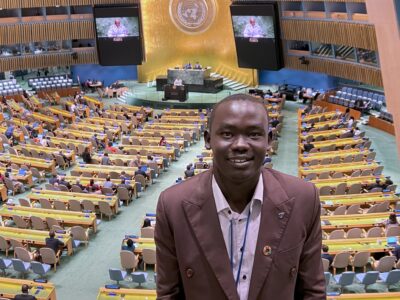
Columbia MPA Environmental Science and Policy Program students were excited to attend the celebration of World Wildlife Day March 3 at the UN Headquarters here in New York. The event “celebrates and raises awareness of the world’s wild animals and plants,” allowing students to learn more about the pressures wildlife face and to connect with global leaders involved in wildlife issues.
Program student Arnaud Goessens is currently working as a consultant at the UN, and coordinated student attendance. The day’s events included panel discussions, speakers and the International Elephant Film Awards. This year’s theme was “The Future of Wildlife is In Our Hands.”
CITES, or the Convention on International Trade in Endangered Species of Wild Fauna and Flora, is a multilateral treaty to ensure that the trade in specimens of wild animals and plants between nations does not threaten the survival of these species. Today, 181 member nations have signed on to CITES, and it is regarded by CITES Secretary-General John E. Scanlon as “the most successful of all international environment-related agreements.”

This event was especially valuable for 10 students in the MPA-ESP Workshop in Applied Earth Systems Management III, currently working on a wildlife trafficking consulting project for the Wildlife Conservation Society. The students are analyzing proposals for species that could be submitted to the CoP17 (Conference of the Parties) in South Africa by those who have signed onto CITES. These include the African rhinoceros, devil rays, African grey parrot and pangolin species—all of which have been significantly impacted by trade for their parts and products in the international market.
This year marked the third observance of World Wildlife Day, a product of a Thailand-sponsored UN Resolution adopted at CoP16 of CITES, held in Bangkok, Thailand. The March 3 date was formally recognized by the UN in December 2013.
The students’ proposal would build on recent progress made in 2015 on international wildlife conservation. The UN General Assembly adopted a specific resolution, the first of its kind, recognizing specific targets “tackling illicit trafficking in wildlife,” in September 2015 as part of the UN’s Sustainable Development Goals.
Just the illegal trade of wild flora and fauna, not including marine or timber species, has an estimated value of $20 million dollars. This trade devastates populations of many species worldwide including sharks, tigers, elephants, rhinos and tuna.
A goal of World Wildlife Day is to increase public and governmental awareness and strengthen party commitments to CITES. In his keynote address, Scanlon emphasized that this would assist in reducing the harm brought on by the illegal trade, “developing compliance procedures, bringing new marine and timber species under CITES trade controls, making the best use of emerging technologies and strengthening cooperative implementation and enforcement efforts.”
Students attended the World Wildlife Day panel featuring many leaders in the international conservation movement. Moderated by Scanlon, panelists included:
- Robert Dreher, associate director, U.S. Fish and Wildlife Service
- Nik Sekhran, chief of practice and director, Sustainable Development Cluster, Bureau of Policy and Programme Support, United Nations Development Programme
- John Robinson, executive vice president, conservation and science, Wildlife Conservation Society
- Tania Paratian, manager intergovernmental relations, World Wildlife Fund International
- Heiko Thoms, ambassador, chargé d’affaires a.i. of Germany to the UN.
“As future policy communicators and environmental professionals, it remains of utmost importance that we as students engage with experts and world leaders at events such as the World Wildlife Day celebration at the UN in New York,” said MPA-ESP student Jamie Hanson. “We were able to listen, learn, discuss and ask questions of important voices in wildlife conservation and international UN leaders who have a stake in the issue of illegal wildlife trafficking.”
“The world’s wildlife, whether charismatic or lesser known,
is facing many challenges. The biggest threats to wildlife are habitat
loss as well as overgrazing, farming and development. Poaching and trafficking in wildlife driven by transnational organized crime groups pose the most immediate threat to many iconic species. Elephants, pangolins, rhinoceros, sharks, tigers and precious tree species are among the most critically poached and trafficked species across the world.”
— John E. Scanlon, CITES secretary-general



